Stay Updated with Everything about MDS
Thank you! Your submission has been received!
Oops! Something went wrong while submitting the form.
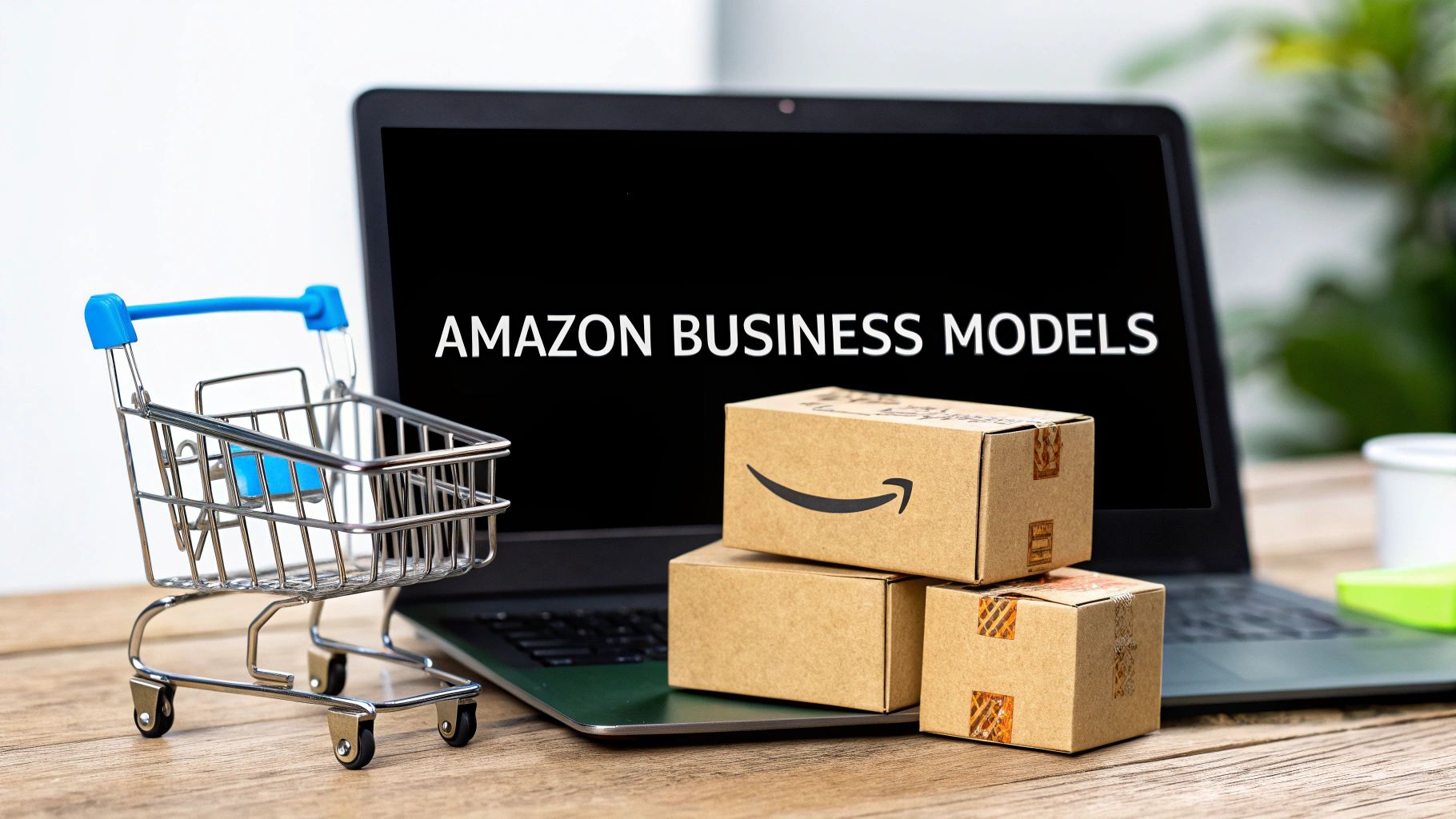
Chilat Doina
August 23, 2025
Choosing an Amazon business model is like picking a blueprint for your e-commerce house. It dictates everything: how you source products, how you handle inventory, and ultimately, how you make money. The big three you'll hear about most often are Private Label, Wholesale, and Arbitrage.
Jumping into the Amazon marketplace can feel overwhelming. There are a million different paths you can take, and the one you choose—your business model—is the single most important decision you'll make at the start. It shapes your startup costs, your day-to-day grind, and your long-term growth potential.
So, who are you as a seller? A treasure hunter, a brand builder, or a bulk buyer?
Before you commit a single dollar, the first step is always conducting effective market research. This isn't just a suggestion; it's the foundation that keeps you from making expensive guesses and helps you pick a path that actually meets a real customer demand.
This image breaks down how a giant like Amazon actually makes its money. It's not just about selling their own stuff.
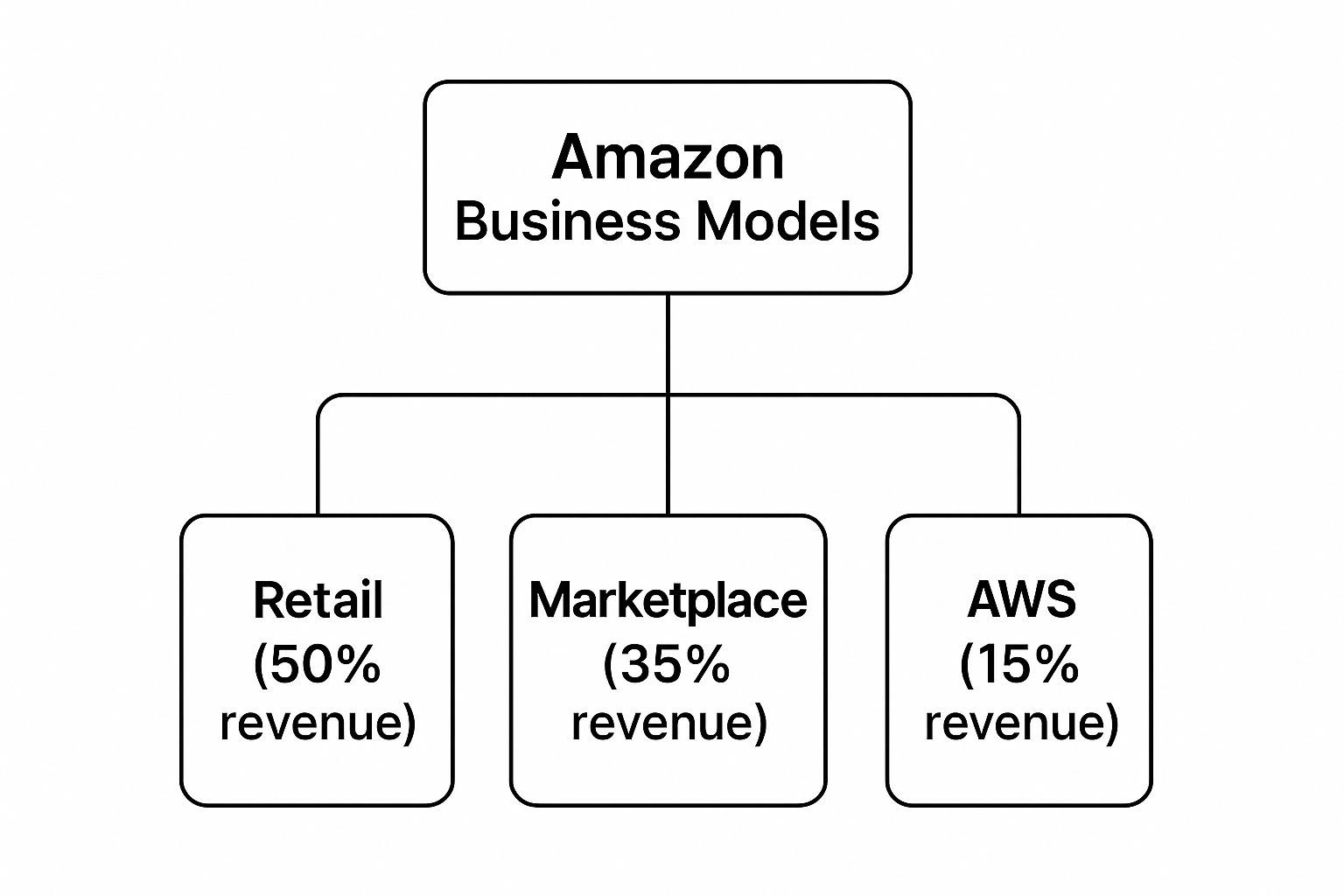
Look closely, and you'll see that third-party sellers—people like you and me—are a massive piece of the pie. That right there is the opportunity.
The sheer scale is hard to wrap your head around. Amazon has something like 9.7 million sellers worldwide, with nearly 1.9 million of them actively selling every month. This massive seller base is why Amazon can offer a mind-boggling catalog of over 350 million products.
The goal isn’t to find the "best" Amazon business model in a vacuum. The goal is to find the best one for you—your budget, your tolerance for risk, and what you want your life to look like in a few years.
To help you get a bird's-eye view, let's compare these models side-by-side.
This table offers a high-level look at the main business models, breaking down what you can expect in terms of cost, effort, and potential returns.
Think of this as your starting point. Each path has its own unique terrain.
In the next few sections, we're going to dive deep into each one. We’ll map out the entire process, weigh the pros and cons, and look at who is best suited for each journey. By the end, you'll have the clarity you need to pick your strategy and start building with confidence.
Think of arbitrage as the ultimate treasure hunt for e-commerce entrepreneurs. It’s one of the most popular Amazon business models for a reason—it’s simple, low-risk, and you can get started fast. The entire game is about finding a product for cheap in one place and flipping it on Amazon for a profit.
This model really boils down to two distinct hunting grounds.
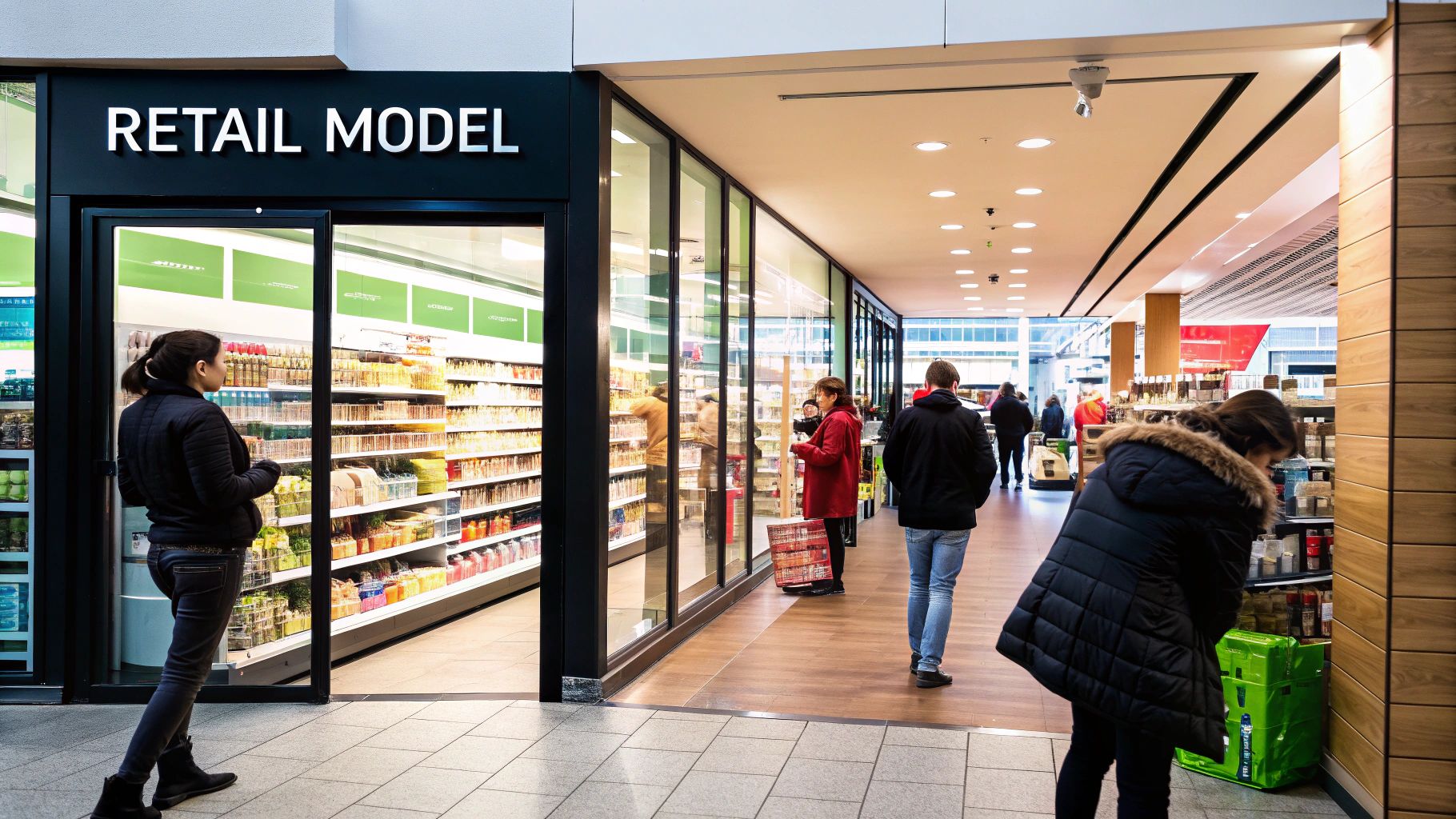
Retail Arbitrage is the classic, boots-on-the-ground method. You’re physically heading into stores like Walmart, Target, or even local discount outlets. With your smartphone and the Amazon Seller App in hand, you become a deal detective, scanning barcodes on clearance shelves to see exactly what a product sells for on Amazon and how much money you stand to make.
Online Arbitrage is the same hunt, just from your couch. Instead of driving around town, you’re scouring the web for online clearance racks, coupon codes, and flash sales. You buy low from one retailer's site and sell high on Amazon, shipping everything without ever leaving home.
Whether you’re in a physical aisle or browsing a website, the core process is a simple, repeatable loop. It’s the perfect way to learn the ins and outs of the Amazon machine without putting a ton of cash on the line.
Here’s what that cycle looks like:
Success here is all about volume and speed. You're constantly on the lookout for new deals because that amazing clearance find is almost never coming back in stock.
Arbitrage is a fantastic launchpad, but it’s crucial to know its limits. You’re trading long-term scalability for low upfront risk. The skills you'll pick up are priceless, but the business model itself can be a real grind.
Key Advantages of Arbitrage
Common Disadvantages of Arbitrage
Real-World Scenario: Imagine a new seller starting with $500. They hit the stores every weekend, doing retail arbitrage. They reinvest every penny of profit back into buying more inventory. After six months of grinding, they've turned that $500 into $3,000 and have a deep, practical understanding of how Amazon works. Now they can take that cash and knowledge and pivot to a more scalable model, like wholesale.
Think of arbitrage as your on-the-job training. It teaches you the single most important skill—how to find winning products—and gives you the seed money to fund your next big move.
If you think of arbitrage as an Amazon treasure hunt, then private label is more like being an inventor. This is where you level up from just selling products to actually building a brand—a real, tangible asset you can grow and even sell one day.
You're not just finding and flipping someone else's stuff. You're creating something new, something that is uniquely yours.
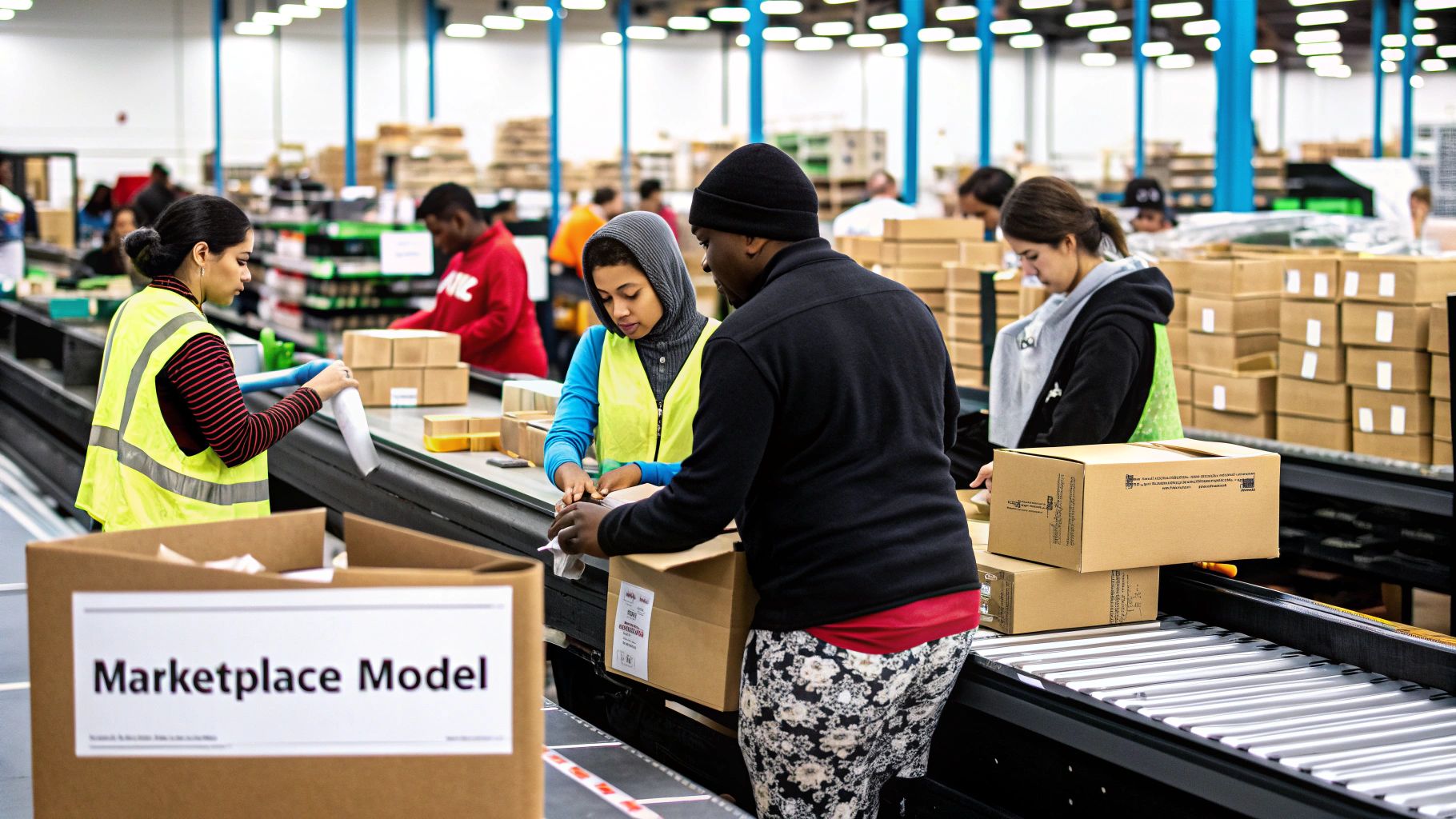
The whole game is about finding a generic product that people already want, figuring out how to make it better, and then slapping your own brand name on it. You get to call all the shots: the product’s features, the quality of the materials, the logo, the packaging—everything.
Let’s be clear: building a brand from scratch is a lot more work than reselling. But the potential payoff is in a completely different league. It's a structured process that takes you from a simple idea all the way to a thriving e-commerce business.
Here's what that workflow usually looks like:
This model has the highest ceiling for growth, but it also comes with the most risk. You’re not chasing a quick buck; you’re making a long-term commitment to building an asset.
Major Advantages of Private Label
Key Disadvantages to Consider
Success in private label hinges on knowing your customer inside and out. It's not enough to just launch a product; you have to know who you're launching it for.
The Amazon customer base is huge and diverse. While over 50% of buyers are male, the platform's reach is broad and constantly expanding into new markets like Australia, Brazil, and the Middle East. Countries like the United Arab Emirates and Saudi Arabia are some of the fastest-growing. Spotting trends in these areas can help you find underserved niches ripe for a new brand.
Case Study in Action: A seller noticed that almost every garlic press on Amazon was flimsy and a nightmare to clean. They found a manufacturer to create a heavy-duty, ergonomic stainless steel version and threw in a silicone peeler as a bonus. They designed slick, minimalist black packaging and aimed their launch at home cooks who appreciate quality kitchen gear. A year later, their brand was a top seller, commanding a higher price and racking up thousands of 5-star reviews.
This is the private label playbook in action: find a pain point, create a better solution, and build a brand around it.
It’s about more than just selling an item; it’s about earning a reputation for quality. To protect that reputation, proper trademark registration and protection is non-negotiable—it’s your best defense against copycats.
To really get into the weeds of this model, check out our complete guide on https://milliondollarsellers.com/blog/private-labeling-on-amazon.
If arbitrage is the treasure hunt and private label is the inventor's workshop, then wholesale is like becoming a professional distributor for brands everyone already knows and loves. It’s a compelling middle ground between the other Amazon business models—way more stable than arbitrage, but less intensive than building a new brand from scratch.
The idea is simple. You buy products in bulk directly from an established brand or one of their authorized distributors. Because you're buying a ton of units at once, you get a deep discount. Then, you just turn around and sell those same items on their existing Amazon listings, making your money on the difference between your wholesale cost and the retail price.
Stepping into wholesale means you're graduating from a solo hustler to a legitimate business owner. This model isn't about chasing one-off deals in a retail store; it's about building real, long-term B2B relationships to create a sustainable pipeline of proven products.
The whole game is built on legitimacy and scale.
It's this structured workflow that makes wholesale so predictable and scalable.
Wholesale really clicks for sellers who are ready to move past the entry-level grind and build a more systematic operation. The biggest perks come from piggybacking on products that already have a built-in audience.
This focus on logistics over marketing is a huge draw. Plus, the whole operation is made infinitely easier with services like Fulfillment by Amazon (FBA), which over 80% of sellers use. Tapping into Amazon’s massive logistics network means you can handle huge volumes of inventory without ever touching a box yourself, all while ensuring customers get their orders fast. You can dig into more trends like this by checking out these key Amazon statistics on SalesDuo.com.
As great as it sounds, the wholesale model comes with its own set of professional-grade hurdles. The barriers to entry are definitely higher than arbitrage, and your profit margins are usually going to be thinner than what a successful private label brand can pull in.
The biggest challenge in wholesale isn't finding a product; it's convincing the brand that makes the product that you are a worthy partner.
Competition is another constant you have to deal with. Since you’re selling on an existing listing, you'll almost always be sharing the Buy Box with the brand itself and other authorized resellers. This can quickly turn into a race to the bottom on price, which just eats away at your profits.
Finally, this model takes real capital. Suppliers often have MOQs that run into the thousands of dollars, meaning a big chunk of your cash will be tied up in inventory at all times.
So far, we’ve covered the big players: wholesale, retail arbitrage, and private label. But what if you're looking for something a bit different? Two other fascinating paths exist on Amazon, each catering to a completely different type of entrepreneur: dropshipping and Amazon Handmade.
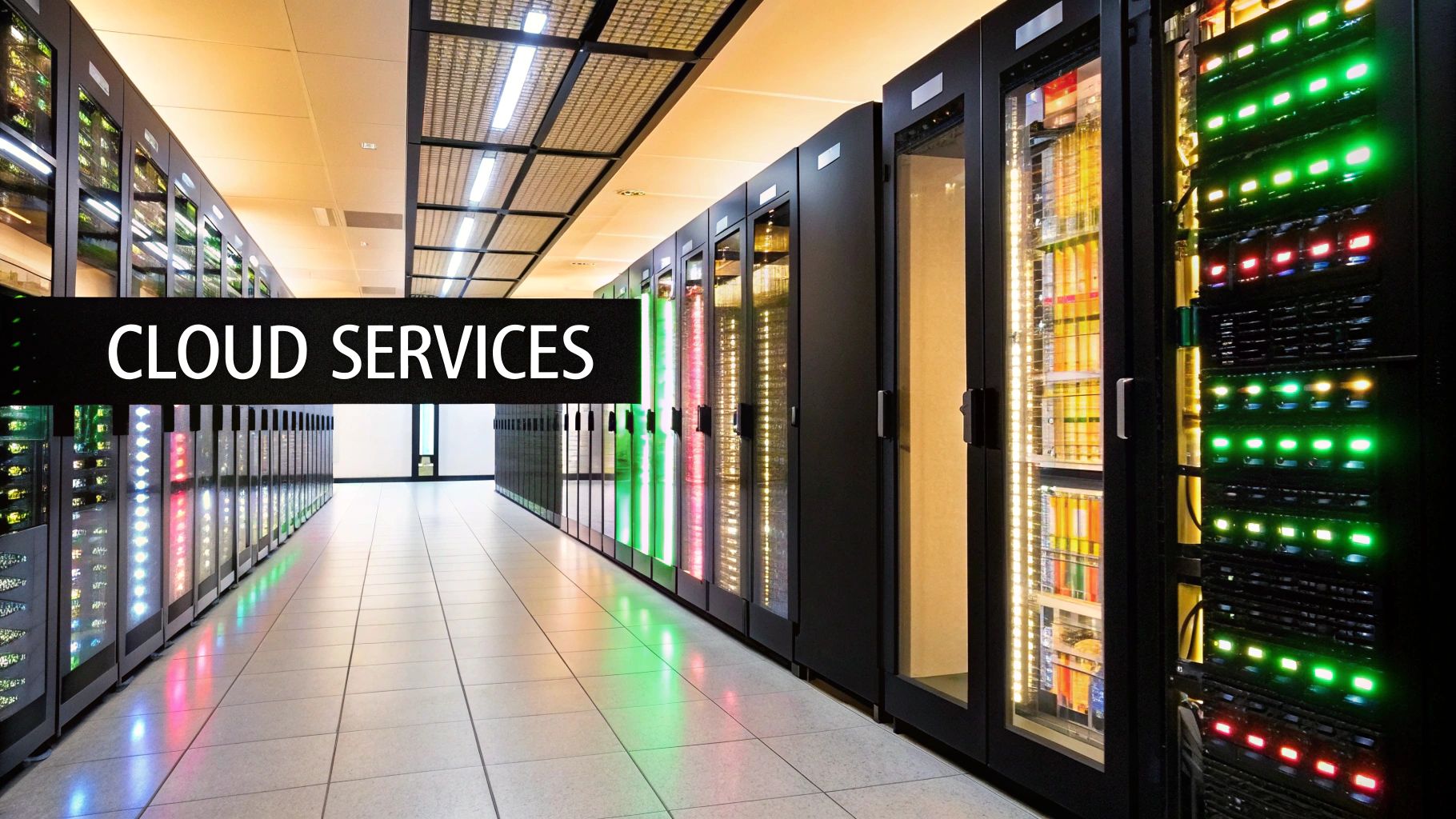
Let's start with dropshipping—the ultimate hands-off approach to selling. Imagine yourself as a digital curator. You find a great product from a supplier, list it on Amazon, and when a customer places an order, you simply forward that order to your supplier. They handle the picking, packing, and shipping directly to the customer's doorstep. You never even see the product.
This model is a magnet for new sellers because the startup costs are ridiculously low. You don't buy any inventory until a customer has already paid you for it. But here’s the catch: your entire business balances on the reliability of your supplier and your strict compliance with Amazon's rules.
Amazon’s dropshipping policy is ironclad. You must be the seller of record on all paperwork. The box, the invoice, everything must identify you, not your supplier. One slip-up here can get your account shut down in a heartbeat.
Dropshipping sounds like a dream, but it's really a game of trade-offs. You swap the risk of holding inventory for a near-total lack of control over the customer's experience.
The Upside of Dropshipping:
The Downside of Dropshipping:
On the opposite end of the spectrum is Amazon Handmade. This isn't just another product category; it's a gated, artisan-only community built for people who create their products with their own two hands. Think of it as Etsy, but with the colossal reach of the Amazon ecosystem.
To get in, you have to go through a rigorous application process to prove your products are genuinely handcrafted by you or a small team. This vetting process is a huge benefit—it weeds out the mass-produced competition and creates a marketplace where uniqueness and quality are the main event.
For a creator, this is a golden opportunity. Amazon commands nearly 40% of the entire U.S. e-commerce market, an audience that would take a solo artisan years to build on their own. If you want to dive deeper into what that market share means for sellers, these e-commerce market statistics are eye-opening.
Why Artisans Love Amazon Handmade:
At the end of the day, both dropshipping and Handmade are specialized Amazon business models. Dropshipping is tailor-made for the seller who values low financial risk above all else. Handmade, on the other hand, is the perfect launchpad for creators ready to turn their passion into a thriving business.
Choosing the right Amazon business model is less about finding the "best" one and more about finding the best one for you. Your budget, goals, and how much risk you're willing to take on will point you in the right direction. This table breaks down which model aligns best with different types of entrepreneurs.
Think of this as a starting point. Your journey might even involve blending models as your business grows. The key is to be honest about your resources and what you truly want to achieve.
Choosing between the various Amazon business models isn't about finding a magic bullet. It's about taking an honest look in the mirror. The "best" model is simply the one that fits your budget, schedule, and goals like a glove.
So, how do you find that perfect fit? Start by getting real about four critical areas of your life as a budding entrepreneur.
Let's start with the basics: what are you bringing to the table? The answer comes down to your capital and your time.
Capital: How much cash can you actually put into this? If you’re working with less than $1,000, arbitrage is really your only practical starting point. On the other hand, wholesale and private label demand more skin in the game, usually requiring at least $3,000 to $5,000+ just to get off the ground.
Time: How many hours a week can you realistically pour into this business? Retail arbitrage will have you pounding the pavement, while launching a private label product is a massive upfront time sink for research and development. Models like online arbitrage and dropshipping tend to offer a bit more flexibility.
Answering these two questions honestly will immediately filter out the models that just won't work for you right now. For example, if you have a decent amount of capital but are short on time, wholesale with FBA makes a lot more sense than the legwork-heavy retail arbitrage model.
The perfect strategy on paper means nothing if you can't actually execute it. Match your choice to your real-world constraints, and you’ll build a business that can actually last.
Next up, what's the end game? And how much risk are you willing to stomach to get there?
Are you looking to build a nice side hustle, or are you trying to create a valuable brand you can sell down the road? Arbitrage and dropshipping are fantastic for generating cash flow quickly with relatively low risk. Private label, however, is the classic high-risk, high-reward play—you're not just selling products, you're building a brand asset with long-term value.
With roughly three billion shoppers hitting Amazon every month and 53% of that traffic coming from mobile, the sheer scale of the opportunity is staggering, no matter which path you choose. You can see more on Amazon's market reach on Webinterpret.com.
Ultimately, your choice here is a reflection of your entrepreneurial personality. A seller who plays it safe might feel right at home with wholesale, while a creative visionary is practically built for the world of private label.
Diving into the world of Amazon selling can feel like learning a new language. Let's tackle some of the most common questions we see from sellers trying to find their footing.
For anyone just dipping their toes in the water, Retail or Online Arbitrage is hands-down the best place to start.
Why? It has the lowest barrier to entry. You can often get going with less than $1,000, and it forces you to learn the ropes of the Amazon ecosystem—listing products, figuring out sales rank, and managing shipments—without a massive upfront risk. Think of it as your paid internship in the world of e-commerce.
Absolutely. In fact, it's not just possible; it's a common path to success. Many top sellers start with arbitrage to learn the platform and build a cash reserve. Then, they roll those profits into a more scalable model like wholesale or even launch their own private label brand.
The beauty is that the skills you pick up are completely transferable. Mastering product research, calculating profit margins, and navigating Seller Central are foundational, no matter which direction you take your business.
This allows you to grow your business at the same pace as your expertise and bank account.
This is a classic point of confusion. FBA (Fulfillment by Amazon) and FBM (Fulfillment by Merchant) aren't business models—they're fulfillment methods. You can use either FBA or FBM with any of the models we've talked about.
Most sellers lean heavily on FBA. It unlocks the powerful Prime badge, which builds customer trust and can seriously juice your sales. More importantly, it lets you focus on finding great products instead of getting buried in packing tape and shipping labels.
The truth is, it varies. A simple product will cost less to launch than something complex with multiple variations. But a safe, realistic budget to get a private label product off the ground is typically somewhere between $3,000 and $10,000.
That number isn't just for inventory. It accounts for all the crucial steps: ordering samples to check quality, professional product photography (don't skimp on this!), branding and packaging design, Amazon's fees, and—critically—an initial budget for Pay-Per-Click (PPC) ads to get your new product in front of shoppers.
At Million Dollar Sellers, we've seen every one of these Amazon business models scaled to incredible heights. Our exclusive community is where elite 7-, 8-, and 9-figure founders share the exact strategies they use to win. If you're ready to scale past the basics and learn from the best in the business, see if you qualify for MDS. Apply for membership at Million Dollar Sellers.
Join the Ecom Entrepreneur Community for Vetted 7-9 Figure Ecommerce Founders
Learn MoreYou may also like:
Learn more about our special events!
Check Events